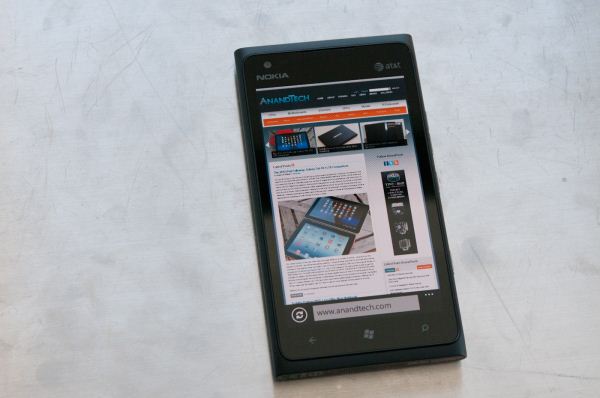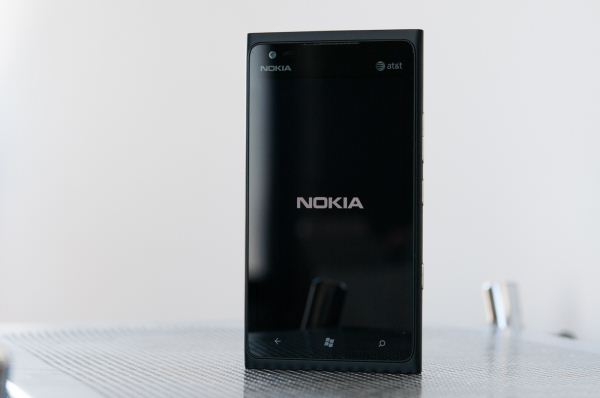Nokia Lumia 900 Review - Windows Phone with LTE
by Brian Klug on April 3, 2012 9:00 PM ESTSumming up the Lumia 900 as a device is pretty easy, it's superficially a beefed up, larger Lumia 800. Spelled out explicitly, the changes are a larger 4.3" SAMOLED+ display with a full RGB stripe, a front facing 720p camera, and LTE connectivity for AT&T. When it launches later in Europe, instead of LTE, the Lumia 900 will bring DC-HSPA+ and all around improved cellular connectivity courtesy MDM9200. The Lumia 900 is thinner, but obviously larger in x and y to accommodate the larger display, but in the hand and pocket the difference isn't all that huge. The end result is a device I can find only positive things to talk about with, and it's the Lumia that finally rounds out Nokia's complete entrant Windows Phone lineup.
For the first time in a while, I'm genuinely excited by a new Windows Phone. With the Lumia 900, it seems as though some of Nokia's rhetoric about being the first OEM to put its best hardware and design forward with the platform is starting to ring true. Similar to our take on the first members of the Lumia family, the 900 is easily the best Windows Phone on the market today.
The $99 launch price is absolutely crazy and very welcome for a flagship phone, particularly one with such high build quality and camera standards. Not only does this obviate other Windows Phones, but it increases competitive pressure on Apple as well as Android smartphone providers. I don't know that there's still a lot of iPhone/Windows Phone cross shopping, but a trend towards even cheaper on-contract prices for high-end smartphones is absolutely welcome.
What we really need to see from Nokia is faster hardware and more power efficient LTE, both of these things are technically possible today (28nm LTE basebands are still not quite available in volume yet) however it's up to Microsoft to actually enforce the platform change. It's amazing what Nokia has been able to do hardware-wise with only a year in the Microsoft camp, particularly when you remember that most smartphone development cycles are in the 12 - 24 month range. While the Lumia 900 is a great Windows Phone today, what will really be interesting is what Nokia will be able to pull off with a full design cycle under its belt.
The Lumia 900 launch in the US is, like I stated before, obviously a big deal for Nokia, and putting its best devices on the table with the 900 makes sense, even if the initial Lumia 710 introduction was something of a puzzling first step. While it's a big deal for Nokia to be launching a flagship phone in the US once more, it really isn't as much of a make or break thing for the Windows Phone 7 platform in general, and that brings me to my next point.
Ultimately the Lumia 900 doesn't really change the balance of power in the smartphone OS competition as it stands right now. Although the version number has advanced on the Lumia 900 (because of changes that needed to accommodate LTE), it's really the same Windows Phone 7.5 Mango we've seen and talked about before. If you're looking for a make or break launch that might upset the balance, wait for the Apollo update.
As it enables dual-core SoCs, the Apollo update leads to our continued plea to Microsoft: please throw better hardware at the Windows Phone platform. No company ever won by being the slowest. Windows Phone may be an extremely efficient platform (it is), but there are only good things to come from combining software efficiency with bleeding edge hardware. Microsoft has learned tremendously from Apple in this regard, but in order for Windows Phone to be more than a third runner up it needs to push the envelope just as much as Apple has been. Microsoft will eventually adopt Krait, and 28nm LTE is equally inevitable, but it would just be nice to see those things sooner rather than later on Windows Phone. At some point for a platform to be a winner, it must actually be industry leading. I suspect all of this will come as a part of Microsoft's Windows 8 strategy. Waiting is never easy.












128 Comments
View All Comments
NeoteriX - Wednesday, April 4, 2012 - link
Google Maps:10 miles from a given point on a map.
...it's enough for all of Manhattan and nearly all of New York City.
Braumin - Wednesday, April 4, 2012 - link
My wife has the Lumia 800. It is a great phone, and the 900 just builds on that. Thank God they got rid of the magnetic door over the USB port.I'm excited to see what Nokia can bring to the table with WP8. I am a big fan of WP7.5, but I know it has some shortcomings. I can't see how those won't all be fixed with WP8 running on the Windows 8 kernel. Obviously Microsoft and Nokia don't want to talk about it (which is too bad) but for business reasons, it makes sense, but all the complaints about hardware should evaporate. Windows 8 already has support for high ppi displays, multicore, LTE, and everything else. Six months seems like a long time away.
The Lumia 900, especially at the price it is offered, should be a great phone for many people. I'll keep my old LG Optimus 7 until Apollo hits though.
j3ff86 - Wednesday, April 4, 2012 - link
174 nits of brightness is super pathetic. I bet Nokia uses a very aggressive ambient light sensor like they did on the N8 and E7. You can disable the light sensor on those phones with 3rd party software but I don't know if WP7 has similar apps.kyuu - Wednesday, April 4, 2012 - link
It's way beyond sufficient for indoor viewing... the only place you might need more brightness is outside in daylight. I guess you missed the part where Brian said that the clearblack feature was pretty effective at reducing glare/reflections and, due to that, the display was quite visible even in the outdoor daylight setting.If you can see the display clearly even in daylight, why would need or want more brightness? So you can drain the battery faster for no real benefit?
steven75 - Wednesday, April 4, 2012 - link
So it's only bad in real life situations where people use their phone? Ok, then.tipoo - Wednesday, April 4, 2012 - link
That's not what he said. The display has one of the lowest reflection indexes in a phone or tablet, its very good at reducing glare, so even if the brightness in absolute terms is lower, in real world use its pretty good since its not competing with the sun as much.ecuador - Wednesday, April 4, 2012 - link
Ehm... You have a N9 right there? Why don't you post a review? It is way too late now, but better late than never?tipoo - Wednesday, April 4, 2012 - link
It's an 800 with a dead OS. There's your review :)Beerfloat - Wednesday, April 4, 2012 - link
You mean it's an 800 but with another dead OS right :)But seriously, bring on the HTC One X review. Now there's a practically perfect smartphone.
tipoo - Wednesday, April 4, 2012 - link
Agreed, but I want the One X with Krait rather than Tegra 3, that one's not out yet.